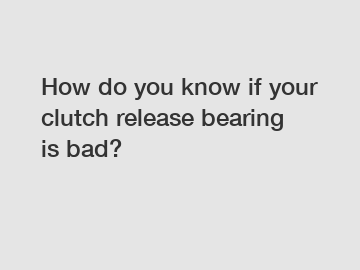How do you know if your clutch release bearing is bad?
How do you know if your clutch release bearing is bad?
If you're experiencing problems with your clutch, there's a possibility that the clutch release bearing is to blame. This crucial component plays an essential role in the smooth operation of a manual transmission vehicle. So, how can you tell if your clutch release bearing is bad? Let's explore some common signs that indicate a faulty release bearing and discuss the steps you should take to address the issue.
1. Strange Noises:

One of the primary indications of a bad clutch release bearing is the presence of unusual noises. You may hear a continuous chirping or squealing sound when you press or release the clutch pedal. This noise occurs because the bearings inside the release bearing have worn out or developed excessive play. If you notice such noises, it's crucial to have your vehicle inspected by a mechanic as soon as possible.
2. Bearing Noise Changes with Clutch Engagement:
Another way to determine if your clutch release bearing is faulty is by paying attention to the noise when the clutch is engaged or disengaged. If the noise changes or disappears when you press the clutch pedal, it's a clear indication that the release bearing is the source of the problem. This change in noise occurs because the pressure applied to the bearing changes when the clutch is engaged or disengaged.
3. Vibrations or Shaking:
A worn-out clutch release bearing can also cause vibrations or shaking sensations while operating the clutch pedal. When the bearing is damaged, it may not be able to maintain proper contact with the clutch pressure plate. This can result in an uneven release of the clutch and cause vibrations or shaking. If you experience such symptoms, it's crucial to have your vehicle inspected by a professional to avoid further damage to the clutch system.
4. Difficulties in Shifting Gears:
If you find it increasingly challenging to shift gears smoothly, it could be a sign of a bad clutch release bearing. A faulty release bearing would not allow the clutch to disengage fully, making it difficult to shift gears effortlessly. You may feel resistance or hear grinding noises as you try to change gears. It's important not to ignore these issues as they can lead to more severe transmission problems if left unaddressed.
Now that we have discussed the signs of a bad clutch release bearing, let's explore the steps you should take to address the issue:
1. Inspection by a Professional:
If you suspect a faulty clutch release bearing, it's always best to have your vehicle inspected by a professional mechanic. They have the expertise and tools to diagnose the issue accurately and recommend the necessary repairs or replacements.
2. Replacement of the Clutch Release Bearing:
If your clutch release bearing is indeed bad, the recommended course of action is to replace it. The release bearing is typically an integral part of the clutch assembly, so it's often necessary to replace the entire clutch kit. This ensures that all the components work together seamlessly and helps prevent future clutch issues.
3. Full Clutch System Inspection:
When replacing the clutch release bearing, it's crucial to inspect the entire clutch system thoroughly. This includes checking the clutch plate, pressure plate, and flywheel for any signs of wear or damage. Any worn-out components should be replaced to ensure optimal performance and longevity of the clutch system.
4. Regular Maintenance:
To prevent premature wear and tear of the clutch release bearing, it's essential to follow a regular maintenance schedule. This includes regular inspections, lubrication of the clutch system as per the manufacturer's recommendations, and addressing any issues promptly before they escalate into major problems.
In conclusion, a bad clutch release bearing can cause various problems in a manual transmission vehicle. By paying attention to the signs mentioned above, you can identify a faulty release bearing and take the necessary steps to address the issue. Remember to consult a professional mechanic for an accurate diagnosis and timely repairs or replacements. With proper maintenance and care, you can ensure the smooth operation and longevity of your vehicle's clutch system.
The company is the world’s best deep groove ball bearing advantages, function of release bearing, release bearing function supplier. We are your one-stop shop for all needs. Our staff are highly-specialized and will help you find the product you need.

Comments
0